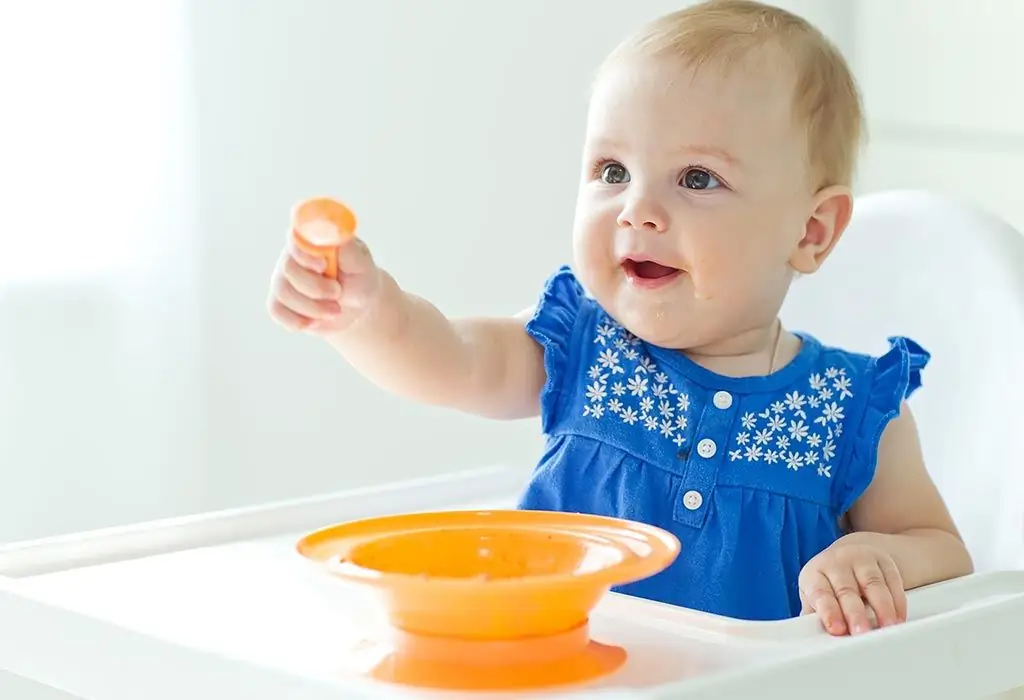2025 Author: Priscilla Miln | [email protected]. Last modified: 2025-01-22 17:55:20
The menu of a child at 8 months is quite diverse. At this age, he is offered a lot of products from the "adult" table, rich in vitamins and other useful substances. Every mother is concerned about the question of how to make the baby's nutrition balanced. After all, a growing organism must receive all the necessary trace elements. Let's get acquainted with the generally accepted norms and recommendations of pediatricians.
Eating at 8 months
Babies eat 5 times a day. At the same time, in the first and last feedings, they are offered breast milk or an adapted formula. Three meals are recommended to be replaced with complementary foods. The intervals between feedings are 4 hours. At night, most babies sleep peacefully, but there are babies with a small stomach volume. If the baby wakes up and wants milk, go to meet him.
The menu of a child of 8 months on artificial feeding differs little from nutritionbabies. Both those and others eat cereals, kefir, vegetable dishes, fruits, meat, cottage cheese. The only difference is in the fish that can already be given to formula-fed babies.
All new foods are introduced carefully, starting with a teaspoon. Do not give babies several unfamiliar dishes on the same day.
Dairy
They must be included in the menu of the child of 8 months. Nutrition with mother's milk should be preserved to maintain the immunity of the crumbs. During the day, the baby eats about 900 g of dairy products. Of course, these are averages. Much depends on the appetite of a particular child.

In addition to milk or a mixture, fermented milk products are introduced into the diet: children's yoghurts and kefirs, biolact, cottage cheese. They are allowed to add fruits or dried fruits for taste. But leave finished products with additives and sweeteners on supermarket shelves. It is safer to stock up on everything you need in a special dairy kitchen. Babies can eat 200 g of kefir per day, up to 50 g of cottage cheese.
This complementary food provides the body with calcium, B vitamins, and maintains a he althy intestinal microflora.
Kashi
For their preparation, you can use buckwheat, barley, rice, corn or oatmeal. It is permissible to cook porridge from several cereals. First they are cooked in water, and later - in diluted milk. Kashi is the main dish on the menu of a baby at 8 months of breastfeeding and artificial feeding.

Twice a week they mix halfyolk, if the baby is not allergic to it. Children suffering from diathesis are not given eggs, but porridge is boiled in water. If the baby refuses to eat, sweeten the dish with fruit additives. You can grind the banana, and cut the apple into pieces and add to boiling water. Ready porridge is allowed to flavor with 5 g of butter. The standard daily serving for this age is 180 g.
Vegetables
In the menu of a child at 8 months, you can safely include:
- potato;
- cauliflower;
- carrot;
- broccoli;
- zucchini;
- pumpkin;
- white cabbage.
Onions are offered with other vegetables. Introduced into the diet and legumes (peas, beans). They are added to soup or puree in the amount of 40 g. According to the norms, a child should eat up to 180 g of vegetables per day.

Here are some useful recipes:
- Vegetable puree. Potatoes, turnips, onions, carrots and peas are stewed in olive oil, finely chopped spinach and parsley are added. The mass is whipped in a blender or scrolled through a meat grinder until smooth.
- Cauliflower soup with zucchini. Vegetables (50 g each) are cut into pieces, boiled until tender. The water is poured into another bowl. Chop the cauliflower and zucchini in a blender, put in the broth, bring to a boil. In the finished soup, you can put butter and half the yolk.
- Vegetable soup. Grated carrots are stewed for 10 minutes in water, then cabbage, green peas, and sliced potatoes are added. Water is poured into the pot,cook vegetables until tender, grind them in a blender. Before serving, the dish is brought to a boil again, a little butter is put in it.
Fruit
They are the main remedy in the fight against beriberi. For a day, the baby should eat up to 80 g of fruit. Children are already familiar with apples, pears. Plums, bananas, peaches and apricots are actively introduced. From berries, you can offer crumbs cherries, blueberries, black currants. Dried fruits are also useful: raisins, dried apricots, prunes. Of these, decoctions are brewed, the first compotes. Monitor the well-being of the baby, the condition of his skin. For children with allergies, be very careful when offering red and orange fruits and berries.

Fruits can be mashed. Interesting combinations of apple and pear with carrots, zucchini, pumpkin. The last two vegetables are pre-boiled or baked in the oven. You can also bake apple slices with cottage cheese. Add some milk for softness. Put fruit in porridge, cottage cheese, yogurt. If there is no allergy to the product, the crumbs are given juice from it, diluted with water in a ratio of 1: 1. Sugar is not added to dishes yet. Children get used to the natural taste of foods.
Bread
It must be included in the menu of a child of 8 months, but not as food. Bread crust is good to scratch the gums. After all, babies are teething. In addition to white bread, introduce your child to crackers, children's cookies, dryers. A child can receive up to 10 g of such products per day. Thanks to them, he gradually learns to bite off pieces, chew them.
Meat
Itfirst introduced to the menu of a breastfed baby. 8 months - an approximate period for children who began to feed from 6 months. Thanks to meat, a growing organism receives animal proteins and useful trace elements: iron, potassium, magnesium, phosphorus.
Complementary foods are best to start with a lean rabbit or turkey. Introduce chicken, lean beef with caution - some children are allergic to them. If you are intolerant to cow's milk, give up veal. For now, fatty pork is banned.

Meat cans for baby food are available in stores. Look for jars marked "Stage 1". Do not buy canned food that contains spices and starch. Many parents prepare mashed potatoes for complementary foods at home. The meat is cleaned of veins, fat, boiled for about an hour. Then carefully grind in a blender or meat grinder to a homogeneous mass without lumps. When everything is ready, add some vegetable oil.
First the child gets 1/2 tsp. meat puree. The next day he is given a whole spoon, by the end of the week the volume increases to 5-6 spoons. After two weeks, the baby can eat up to 50 g of meat per day. It is prepared in the form of mashed potatoes, mixed with vegetables, added to the finished soup.
But meat broths are not yet offered to children of this age. They can irritate the immature gastrointestinal tract and often cause skin rashes. In addition, all the harmful substances that were originally in the meat remain in the broth.
Fish
Meat from 7 months is on the baby's menu forartificial feeding. At 8 months, these babies are gradually introduced to fish. It is a source of phosphorus, calcium, iodine, fatty acids, vitamins D and B. At first, buy sea fish with white meat: pollock, hake, cod. For the preparation of mashed potatoes, you will need a fillet, carefully cleaned of bones. It is boiled and ground in a blender. Fish can be served with mashed potatoes.
Complementary foods are introduced, starting with 1/2 teaspoon. By the end of the month, this amount is increased to 30 g. During the week, fish should appear on the table no more than twice. It is an allergenic product, so carefully monitor the condition of the crumbs. If all is well, after two weeks you can make mashed salmon, pike perch or carp.

You can also serve fish in the form of a delicate soufflé. To do this, boil or stew the fillet, grind it to a state of homogeneous mass along with the yolk. In a frying pan, heat 100 ml of milk, beat with a tablespoon of flour until thickened. In the finished sauce, add 1.5 tsp. butter. Beat the egg white into foam, mix it with the fish, pour in the sauce, lay everything out in a mold. Souffle is prepared in a double boiler or in a conventional oven. In the latter case, the baking sheet is filled with water and a container with fish is placed on it. Be aware that the soufflé will rise slightly as it bakes.
Composing the menu
What should an infant eat for breakfast, lunch and dinner? A sample menu for a baby at 8 months is as follows:
- About 6.00 - morning feeding with mother's milk or selected formula.
- At 10.00 -milk or dairy-free porridge, which can sometimes be seasoned with butter (120 g), for dessert fruit puree 40 g, juice or yogurt 35 g.
- At 14.00 - a hearty lunch, including vegetables and meat. They can be served in the form of soup or puree in the amount of 150 g. A bottle-fed child receives fish dishes 2 times a week. For dessert, offer fruit juice (approximately 30g).
- At 18.00 - the baby can enjoy kefir or yogurt with cookies (120 g), as well as cottage cheese (40 g), fruit puree (up to 80 g) or porridge (60 g) to choose from.
- At 23.00 - last feeding with milk or adapted formula.

Baby menu at 8 months for a week
How to make the food of your favorite crumbs varied? Below is a weekly menu that you can use as an example:
| Day of the week | Eating | Dishes |
| Monday | Tue. breakfast | Oatmeal, applesauce, yogurt |
| Lunch | Vegetable soup with potatoes, zucchini, carrots and onions with turkey, pear juice | |
| Snack | Kefir, cottage cheese with fruits | |
| Tuesday | Tue. breakfast | Buckwheat porridge, cottage cheese with prunes |
| Lunch | Freshly made mashed potatoes with cauliflower, rabbit or fish pate, apple juice | |
| Snack | Rice porridge, yogurt with apricot puree | |
| Wednesday | Tue. breakfast | Corn porridge with pumpkin, pear puree |
| Lunch | Chicken soup, half yolk, banana, compote | |
| Snack | Cottage cheese, baby cookies with kefir | |
| Thursday | Tue. breakfast | Buckwheat porridge with pear, apple puree and plums |
| Lunch | Pumpkin and potato soup with turkey, peach puree | |
| Snack | Yogurt, oatmeal | |
| Friday | Tue. breakfast | Corn porridge, prune puree |
| Lunch | Veal and vegetable puree, currant juice | |
| Snack | Kefir, apple baked with cottage cheese | |
| Saturday | Tue. breakfast | Rice porridge with pumpkin, plum puree, cherry juice |
| Lunch | Soup with meat or fish meatballs, compote | |
| Snack | Buckwheat porridge, for dessert - yogurt with apricot | |
| Sunday | Tue. breakfast | Oatmeal, half yolk, pear and apple puree, apple juice |
| Lunch | Green pea, carrot, cauliflower and rabbit puree, pear juice | |
| Snack | Plum puree, cottage cheese, kefir |
When compiling a menu for a child of 8 months, be guided by his tastes. At this age, kids already have their favorite and least favorite foods. A new product can be mixed into the usual food, gradually increasing its amount. Cook with love and babywill always delight you with an excellent appetite.
Recommended:
6 months baby: development, weight and height. The daily routine of a child at 6 months

Here comes the first little anniversary. Looking at a six-month-old child, we see already noticeable changes in him, he is no longer a newborn baby, but a little man with meaningful actions. The daily routine of a 6-month-old child is already changing significantly, the baby is more active, developed, and curious. The development of a baby at six months contains many unforgettable moments that parents will remember for a long time
The diet of a 10-month-old child on artificial and breastfeeding

According to the recommendations of the World He alth Organization, it is necessary to introduce complementary foods into the diet of a child from six months. The age of introduction of complementary foods may vary depending on individual characteristics, but a child’s diet at 10 months must already include fermented milk products, cereals, vegetables and fruits
Menu for an eight-month-old baby: diet and diet for breastfeeding and artificial feeding

What should be the menu of an eight-month-old baby? When is a particular product introduced if the child is bottle-fed? It is worth understanding this issue before taking action
Child development at 11 months: new skills. Child 11 months: development, nutrition

Your baby is preparing for the first anniversary in his life - he is already 11 months old! He learns to perform new actions, slowly begins to speak, tries to move independently, eat. At this time, the child learns a lot of new and unknown things. What should a baby be able to do in his 11 months and how to care for him?
Breastfeeding is Rules and general principles, the benefits of breastfeeding for a child

Doctors constantly tell expectant mothers that breast milk is important for children, especially in the first year of life. At this time, immunity and important vital functions are established. Breastfeeding is a necessary condition for the proper he althy development of a newborn, it contains all the substances necessary for the baby

